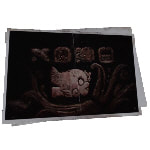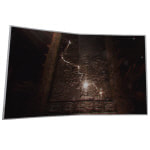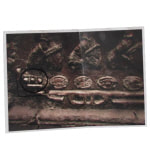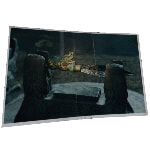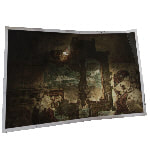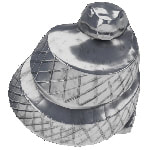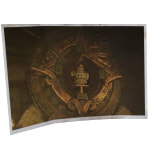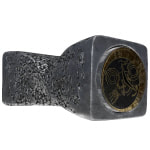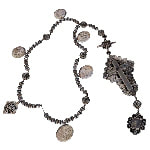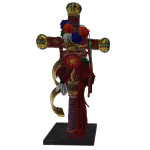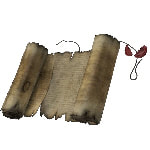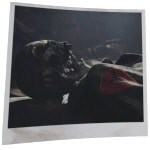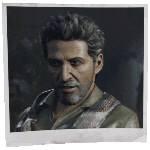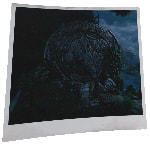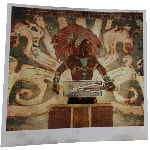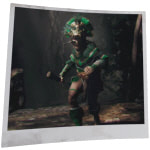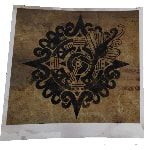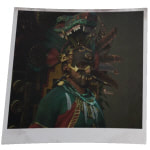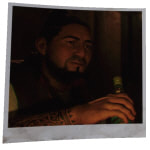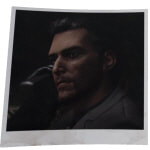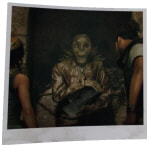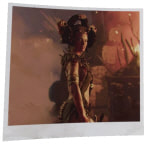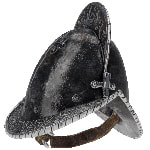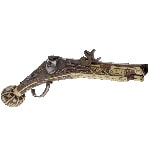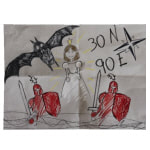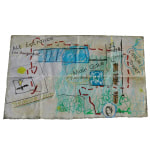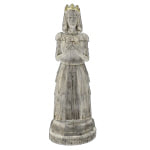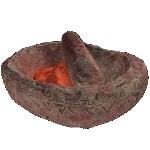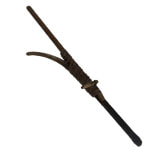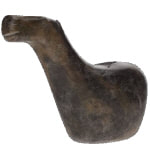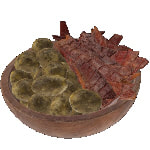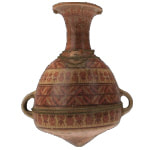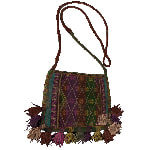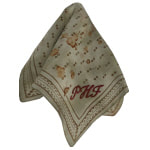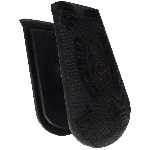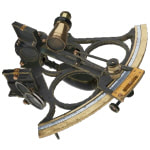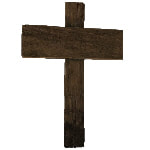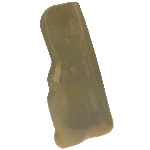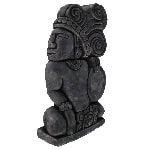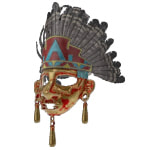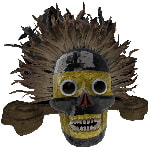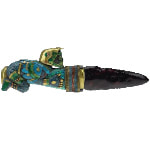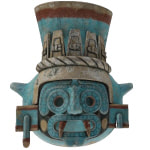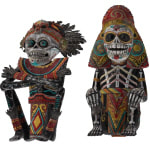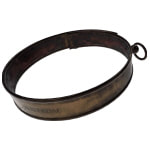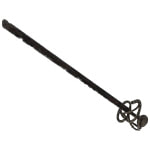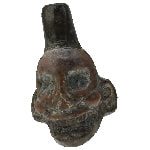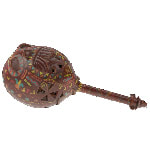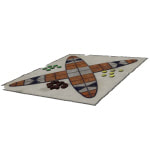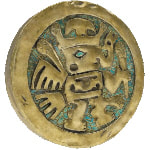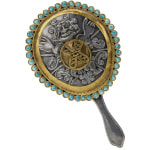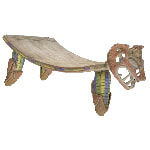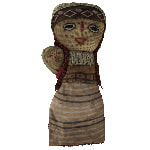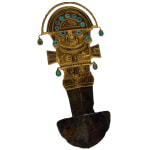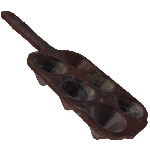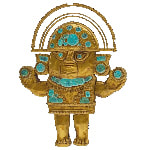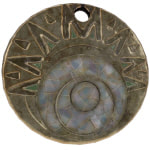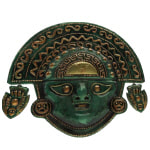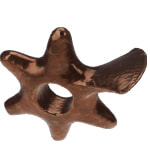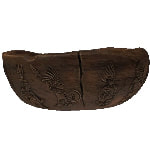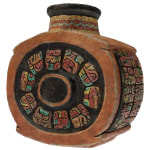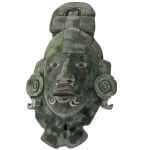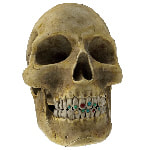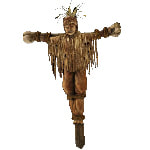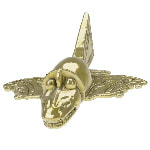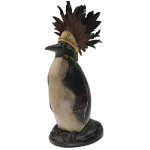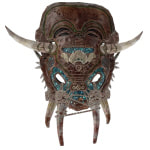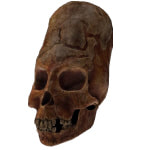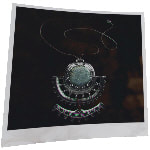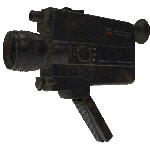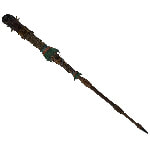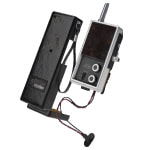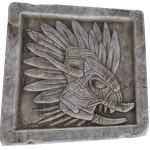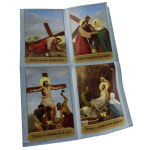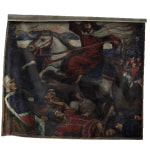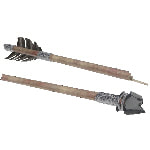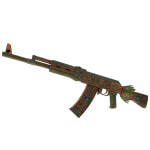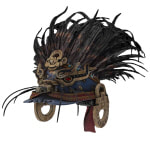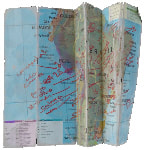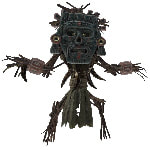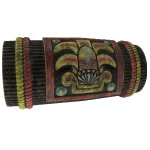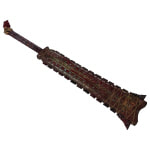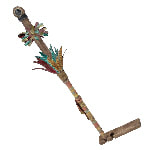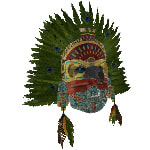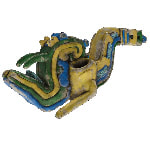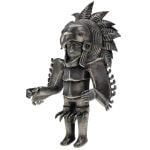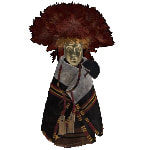Relics
Contents: Path of the Stars | The Missionary | Lara's Notebook | Gates of Hell | Angel De La Cruz | Mystery of the White Queen | Day in the Life of the Inca | Expedition Unknown | A Community in Need | Pantheon of Gods | Conquerors | Day in the Life of the Paititian | Fortune and Glory | The Resistance | Exodus | Metamorphosis | Homecoming | Myth, Magic & Monsters | Subjugating Paititi | Search for the Hidden City | Secrets and Lies | Miracle Mission | Inside Out | Trinity | Handmade Dolls | Cult of Kukulkan
Also See: DLC Relics
Path of the Stars
Photographs and artifacts from my journey in South America.
We covered a lot of ground, through jungles and rivers and caverns, but finally we managed to stop Dominguez. Several people gave up their lives, so that we could continue on, understanding sacrifices are sometimes needed for the greater good.
We covered a lot of ground, through jungles and rivers and caverns, but finally we managed to stop Dominguez. Several people gave up their lives, so that we could continue on, understanding sacrifices are sometimes needed for the greater good.
|
Hidden City Riddle
A photograph. To find the hidden city, go South along the shore until you find the pink fish. Then chase the heart of the serpent to the silver-crowned mountain where the Twins confer. |
Hydra Constellation
A photograph. This is the star Alphard, the solitary one. The brightest star in the Western sky and the “Heart” of the Hydra constellation. Two thousand years ago it set in the West. That’s where I hope to find the hidden city. |
Maya Date
A photograph. In the Maya long count calendar, all dates have five numbers. This numeral was damaged to look like a thirteen, but what if it’s really an eight. That’s a two thousand year difference, and the constellations would be in a completely different position. So the star path would lead West, to somewhere in Peru. The last number on the left pillar is zero. |
|
Key of Chak Chel
A photograph. This dagger is the Key of Chak Chel. I found an inscription near it, “The Key to Ix Chel’s heart unlocks the Cleansing”. |
Path to the Hidden City
A photograph. This is the path to the hidden city. It seems to describe a series of trials. Entering through a jaguar mouth. A spider and an eagle that rises toward a temple, leading to a serpent with a silver eye. |
Silver Statuette
A small silver statuette. This is a serpent-shaped statuette I found in an ancient Maya tomb in the Lost City of Paititi. It’s yet another clue in my search for the Silver Box of Ix Chel. There appears to be some irregular edges, like a key. But a key to what? |
|
Stone Cup
A photograph. A clue to where Lopez took the Silver Box. “The heart of the serpent is in the cup, near the many stone faces.” |
Silver Box of Ix Chel
The Silver Box. The Silver Box of Ix Chel, unlocked by the Key of Chak Chel, and used to summon the god Kukulkan. Funny how something so... slight could be fundamental in creating or averting the end of the world. |
The Missionary
The story of a Spanish Missionary in South America.
Trinity sent Lopez to Peru to find an artifact of great power.
Trinity sent Lopez to Peru to find an artifact of great power.
|
Brigittine Rosary
A rosary. This rosary has six decades, instead of the usual five. A very ornate example of the Brigittine version. There appears to be an engraving. Andres Lopez? |
Decorated Crucifix
A crucifix decorated in Incan knitting. Someone decided this depiction of Christ’s death needed a little sprucing up. It’s amazing how the beliefs of disparate cultures can become intertwined over time. |
Faded Writing
A scroll. The ink is badly faded. It’s difficult to make anything out. Savage... Outrageous... Betrayal... And this isn’t parchment paper. It’s thicker. Animal hide. Or... human, maybe? |
Lara's Notebook
A record of my hunt for Trinity.
Trinity’s ultimate goal is to remake the world by using a powerful artefact called the Silver Box of Ix Chel.
Trinity’s ultimate goal is to remake the world by using a powerful artefact called the Silver Box of Ix Chel.
|
Trinity Badge
An emblem representing Trinity. Trinity is an ancient and secretive organization ruled by an Illuminati-like High Council that has existed since the time before Christ. They are determined to find, and exploit, all of the ancient artifacts of the world. I’ve been hunting them since I found out they killed my father. Jonah and I have tracked down so many Trinity celLs since then, but all of the other ruins and tombs we found were destroyed, except the one in Cozumel. I need to find out what they’re after, what their end game is, and stop them. |
Doctor Dominguez
A photograph of Dr. Dominguez. Dr. Pedro Dominguez is an archaeologist and expert in pre-colonial Maya history. My father mentioned him in his notes more than once. That’s the lead Jonah and I were following up on when we came to Cozumel. His excavation in Cozumel was one of the last places my father visited before he was killed. If there is a connection, I want to find out what it is. I thought Dr. Dominguez was only the leader of the local Trinity cell, I never imagined that he would turn out to be the leader of the High Council of Trinity. |
Ix Chel and Chak Chel
An illustration of the Moon Goddesses. Ix Chel and Chak Chetl are two faces of the same goddess. Ix Chel is the young woman and represents life and healing. She is associated with the full moon. Chak Chel is the old woman and represents death. She is associated with the new moon. Together as the twins: symbols of duality and the cycle of Life and death. |
|
The Silver Box of Ix Chel
An illustration of the Key of Chak Chel unlocking the Silver Box of Ix Chel. According to legend, the Key of Chak Chel and the Silver Box of Ix Chel were created in the heavens for one purpose; to destroy and restore the sun. The ritual can only be performed during an eclipse. Once the ritual is completed, the chosen Avatar will hold the power of the sun within them. Having become the god of creation, Kukulkan, they must sacrifice and release that power to restore the sun. But the Silver Box tempts people with visions of an idealized world they could create with that power; a fantasy of their own mind, an entirely new reality only at the cost of destroying this one. |
The Cult of Kukulkan
A photo of a Serpent Guard. Trinity’s Influence is even wider than I thought. They have controlled Paititi for centuries, where they are known as the Cult of Kukulkan. Their highest ranking members in Paititi are called the Serpent Guards. They are picked at a young age from among the best warriors In Paititi and fight along side the Jaguar Warriors and the Eagle Archers. |
Queen Unuratu
The Heron and Eclipse: Unuratu’s family crest. Unuratu is the rightful queen of Paititi. After a famine that nearly wiped out the city, her family was ousted from power by the Cult of Kukulkan. Her husband, Sayri, died hunting for food on the outskirts of Paititi. Amaru or Dr. Dominguez, Sayri’s brother, felt responsible and took control of the city using resources from Trinity to feed the Paititians until the famine passed. Even though Amaru saved the city, the Cult, in his absence, now rules with arrogance and fear. Unuratu and her rebels are fighting to free the city from the Cult of Kukulkan and restore its ancient bloodline. Unuratu was raised to believe it was her family’s legacy to complete the ritual of the Silver Box of Ix Chel, and restore the sun for another age. |
|
Amaru
A photo of Dr. Dominguez in his Cultist robes. Dr. Dominguez is originally from Paititi. Trinity has had a presence in Paititi since the 1600s. The former Leader of the High Council, Gualtiero de Luca Dominguez, an Italian Cardinal, saw great potential in a little boy and trained him, like a son, to be his replacement. He moved up in the ranks until he became the leader of the High Council. He has lived most of his life outside of Paititi, returning often but not staying long. His real name is Amaru, but as the high priest of the Cult in Paititi, many people call him by his honorary title: Kukulkan. He has brought the Key of Chak Chel home from Cozumel, and has assured his people he will use it to protect them. Amaru wants the Silver Box of Ix Chel to protect Paititi from the encroaching dangers of the outside world, but already he is being tempted by the possibility of remaking the world in his own image. |
Jonah Maiava
A photo of Jonah Maiava. Jonah is a survivor and a good friend. I met him several years ago on my first expedition on board the Endurance. He made me laugh the first time I spoke to him, calling me Little Bird. We've been through so much since then, and after I lost touch with my best friend Sam, Jonah was always there for me. He came with me to Kitezh and helped me find the Divine Source the artifact my father was Looking for when he was killed. After I destroyed the Divine Source to keep it from Trinity’s hands, Jonah helped me hunt them down, cell by cell. When I finished deciphering my father’s notes, Jonah thought that Cozumel was the best pLace to start. At first, I didn’t believe him, but he was right. The site in Cozumel was the only one we found that wasn’t destroyed. Now I know why: Trinity knows there’s a piece of the puzzle missing and I need to find out what it is before they do. |
Commander Rourke
A photo of Commander Rourke. Commander Rourke is a highly trained, multi-decorated veteran of the US Special Forces. His extensive experience with highly classified and sensitive operations, executed with deadly efficiency, brought him to the attention of the High Council. They recruited him based on his record alone. He is the leader of Trinity’s Military Forces and personally leads the Deacon Teams, which have access to custom APCs, called Paladins, and special ops helicopters, called Cardinals. He is Trinity’s second in Command, answering only to the High Council. While Dominguez is the heart of Trinity, Rourke is the fist. Rourke and Dominguez don’t always see eye to eye, but each has a grudging respect for the other. |
|
Andres Lopez
A photo of Andres Lopez. Spanish Jesuit missionary, Andres Lopez, a member of Trinity, was dispatched to find and retrieve the Silver Box of Ix Chex rumored to be in Paititi. Instead of bringing the Box back to the Trinity High Council, he confessed the theft to his old friend, the Emperor of Paititi, Sinchi Chiqa, Unuratu’s ancestor. Together they entered into a plot to hide the Box from Trinity. Lopez went West of Paititi and founded the Mission of San Juan, leaving a path of clues stretching back to Cozumel for Sinchi Chiqa’s descendants to follow when the time came. But while building the mission and the deadly crypts below, the Box’s power corrupted Lopez’s mind. He came to believe that no one was worthy of the power of the sun. He died alone in the dark, consumed by the power of the Box. Soon after, disease severely wiped out the population of Paititi, taking Sinchi Chiqa, and knowledge of the path of the clues that led to the Silver Box, with it. |
The Crimson Fire
A photo of the Crimson Fire. The Yaaxil are the descendants of the creators of the Key of Chak Chel and the Silver Box of Ix Chel. In the centuries since Lopez stole the Box four hundred years ago, they lost their purpose. Now they protect the site where the Ritual of the Silver Box will take place. Even though their minds have faded their purpose remains intact - they will fight and repel anyone entering the holy City of the Serpent. They are led by a priestess known as the Crimson Fire. She represents Chak Chel and along with Ix Chel, she is charged with completing the ritual of the Silver Box and guiding Ix Chel in her sacrifice of the sun’s power. Once it is completed, the Crimson Fire and all the Yaaxil will return to the heavens, where the Key and the Box were forged. |
Gates of Hell
A Spanish scribe continues to recount this mission.
Lopez had a change of heart and betrayed Trinity, but then he sacrificed all of his men just to reach the Silver Box of Ix Chel. Where is the line between determination and obsession?
Lopez had a change of heart and betrayed Trinity, but then he sacrificed all of his men just to reach the Silver Box of Ix Chel. Where is the line between determination and obsession?
Angel De La Cruz
More adventures of the scribe Serrano.
Lopez created a new identity and purpose. In some ways, I suppose I should be thankful. He kept the Silver Box out of Trinity’s hands for close to five hundred years.
Lopez created a new identity and purpose. In some ways, I suppose I should be thankful. He kept the Silver Box out of Trinity’s hands for close to five hundred years.
|
Wheel-Lock Pistol
An ornate firearm. A wheel-lock pistol. Never mass-produced and banned in the Holy Roman Empire. Ostentatiously decorated. A bit much for a missionary. But maybe a fitting weapon for an egoist such as Lopez. There’s some damage to the pommel, but otherwise the weapon seems in fine condition. |
Mystery of the White Queen
The Great Lara Croft goes on a journey of intrigue and peril as she unravels the Mystery of the White Queen: an epic tale of adventure.
I used to love to play make believe. Back then, everything was a great adventure. I wonder when I stopped having fun?
I used to love to play make believe. Back then, everything was a great adventure. I wonder when I stopped having fun?
|
Enigmatic Clues
A sketched depiction of clues leading to the White Queen. This enigmatic illustration, recovered from a cursed and empty mausoleum, might be what our brave adventurer needs to finally find the lost treasure of the White Queen. She’s managed to decipher the ancient text and has found a series of clues. A set of coordinates, a giant bat and a series of game pieces in a line. The intrepid Lara will have to figure out what they all mean. |
Hand Drawn Map
A map showing the location of the Forbidden Tomb. It has taken our hero years to piece this map together. Spending nights in dusty libraries going through ancient tomes. Exploring sunken ships, stripped of treasure. And chasing down any lead, no matter how faint it may be. Is she can recover the treasure, our brave adventurer may prove herself worthy of being Lord Richard Croft’s assistant. |
Family Photo
A photo from our trip to Hurghada. I think this is from when we walked the El Memsha. I don’t remember much except for how spicy the bazaar smelled. Mom looks so happy. So does Dad. It’s not fair. Why did she have to die? |
Day in the Life of the Inca
Everyday items in Paititi.
These items seemed to be an odd combination of Inca traditions with more than a touch of Maya influence. It speaks to the mingling of the two cultures.
These items seemed to be an odd combination of Inca traditions with more than a touch of Maya influence. It speaks to the mingling of the two cultures.
|
Bowl of Powder
Quechua A bowl of cinnabar powder. Cinnabar was used in the ancient past for producing a bright orange pigmentation on ceramics, murals, tattoos, and in religious ceremonies. |
Chaki Taklla
Quechua A chaki taklla. This is a traditional foot plough still used in the Andes today, even outside Paititi. Sometimes the simple ways are the best. |
Llama Figurine
Quechua A llama figurine. The canopa serves as a receptacle for offerings of cocoa and animal tallow. The stuffed canopa is thrown into the farmer’s field at the start of the harvest season as a gift for Pachamama, the mother god. It is said, if the present is accepted, the farmer will yield large crops and a successful breeding season. |
|
Ch’arki and Chunos
Quechua Some preserved food. The Inca use a combination of freeze-drying and salt to preserve just about anything edible. Ch’arki and chunos are basically meat and potatoes. Delicious. |
Urpu
Quechua A storage jar. These ceremonial ceramic jars are used to store corn beer, or chichi. The bottom of these urpu are usually pointed, to aid when pouring into smaller serving containers. |
Chuspas
Quechua A woven bag. The people of the Andes have been perfecting the art of weaving for thousands of years. This chuspas is a wonderful example. Woven of llama or alpaca hair and traditionally used to carry cocoa leaves it clearly highlights the weaver’s skill. Beautiful. |
Expedition Unknown
Items related to Percy Fawcett’s final expedition.
Percy Fawcett must have learned some key information while in Brazil that caused him to venture West into Peru in search of Z. But the jungle got the better of him and he died before making his discovery. Jack, just as driven as his father, refused to give up. He pushed on, convinced Z was close.
Unfortunately, the quest claimed Jack and Raleigh Rimmel as well, leaving poor Nina Fawcett without a husband or a son... and the world wondering what happened. Until now that is.
Percy Fawcett must have learned some key information while in Brazil that caused him to venture West into Peru in search of Z. But the jungle got the better of him and he died before making his discovery. Jack, just as driven as his father, refused to give up. He pushed on, convinced Z was close.
Unfortunately, the quest claimed Jack and Raleigh Rimmel as well, leaving poor Nina Fawcett without a husband or a son... and the world wondering what happened. Until now that is.
|
Handkerchief
A handkerchief. The monogram reads: PHF. That has to stand for Percival Harrison Fawcett. |
Pistol Parts
Pistol grips. Whatever weapon these were attached to has rusted away in the jungle’s humidity. There’s something etched on them. Can barely make it out. P.H. Faw- Percy Fawcett! But we must be thousands of kilometres from his last known position! |
Sextant
A sextant. In the early nineteenth century, this was used to measure the angle between an astronomical object and the horizon for the purposes of celestial navigation. There’s an inscription here... “To my son, Jack. May you never lose sight of your horizons.” |
A Community in Need
Items collected in and around the village of Kuwaq Yaku.
These people have nothing, but they still push on, not just trying to survive but to cooperate, cohabitate, and make the world a better place. It’s touching and makes a person wonder if maybe they aren’t a little too self-centered.
These people have nothing, but they still push on, not just trying to survive but to cooperate, cohabitate, and make the world a better place. It’s touching and makes a person wonder if maybe they aren’t a little too self-centered.
Pantheon of Gods
These are representations of the gods of the Aztecs.
When I was younger, the Aztec pantheon seemed terrifying, like a horror movie. So, it makes sense the Cult of Kukulkan would adopt parts of the mythology. If the people of Paititi believe the worshippers as brutal as the gods themselves, they would be easier to intimidate, and eventually control.
When I was younger, the Aztec pantheon seemed terrifying, like a horror movie. So, it makes sense the Cult of Kukulkan would adopt parts of the mythology. If the people of Paititi believe the worshippers as brutal as the gods themselves, they would be easier to intimidate, and eventually control.
|
Bloodletter
Yucatec A depiction of the Aztec god Tonatiuh. This is Tonatiuh, the sun god and ruler of the Aztec heaven, which they called Tollan. He was literally the sun itself, the fifth one in fact, presiding over the fifth age after the four previous suns had perished. The Aztecs believed they had to sacrifice to him regularly, or else he would refuse to move across the sky. He was strongly associated with eagles, unsurprisingly, and was often depicted wearing their feathers, and carrying weapons such as arrows and shields, or instruments specifically created for human sacrifice. |
Gold Mask
Yucatec A depiction of Xipe Totec, the Flayed God. This is the Aztec god Xipe Totec, who presided over the cycle of life, death, and rebirth in all its forms, including agriculture, vegetation in general, revolutionary conflict, and skin diseases. He tore his own skin off to feed his people, and is usually depicted wearing a suit of human flesh. This self-flaying may account for how often he’s shown wearing stripes of different colors, predominantly yellow but also tones of red and tan. After wearing the flesh of their captives for twenty days, devotees of Xipe Totec would hold onto the skins for their medicinal properties. |
Mask of Tezcatlipoca
Yucatec A depiction of the Aztec god Tezcatlipoca. That black and yellow stripe across his face marks this as Tezcatlipoca, a very important god to the Aztecs. Let’s see if I can remember everything he was associated with... jaguars, hurricanes, the night winds, the night sky, earth, the North, sorcery, beauty, temptation, leadership, war, strife, interpersonal conflict in general – and of course obsidian and divination. His right foot is often replaced with a piece of reflective obsidian, which the Aztecs used as mirrors, and these mirrors figured in shamanic rituals and prognostications. Tezcatlipoca literally means “Smoking Mirror”. |
|
Antique Knife
Yucatec A bloody knife. An antique knife, possibly Aztec in origin. There is fresh blood on this blade, but it seems as though someone tried to wipe it clean. The edge hasn’t been sharpened in years... |
Tlaloc Vase
Yucatec A depiction of Tlaloc, Aztec god of rain. Bulging eyes, fangs... This is Tlaloc, the Aztec god of rain and storms. In his gentler temperament, he’s also the god of water and fertility, bestowing life and sustenance. But on the other side of the coin he’s responsible for thunder and lightning, hail, and the other destructive aspects of water – including erosion, affiliating him with caves, pools, and springs. Oddly enough, he lives in a mountain. His bird is the heron, but he’s associated also with animals like snails, frogs, and other amphibians. |
Lord and Lady of the Dead
Yucatec A depiction of the gods Mictlantecuhtli and Mictlancihuatl. These are the king and queen of Mictlan, the principal underworld of Aztec mythology. Mictlantecuhtli was the most prominent of the gods associated with death. He was often depicted as a skeleton with eyeballs in his skull sockets, and his responsibilities included looking after the souls of the departed. His wife Mictlecacuatl presided over festivals of the dead, which are precursors to the modern Dia de los Muertos traditions. |
Conquerors
Some of the history of the Spaniards’ arrival in South America.
500 years ago the conquistadors wiped out or subjugated entire civilizations, just to fill their coffers with shiny metals. To think how different the world might be today, had they not cut their swath across the continent.
500 years ago the conquistadors wiped out or subjugated entire civilizations, just to fill their coffers with shiny metals. To think how different the world might be today, had they not cut their swath across the continent.
|
Slave Collar
A slave collar. These collars were used aboard the Nostromo, likely ferrying the captured indigenous people back to Spain to be sold as slaves. I wonder how it ended up here? |
Rusty Sword
An espada ropera. Even rusted out, you can tell this is a quality weapon. It was likely manufactured in Toledo. The city was renowned for their steelwork. The notches on the blade suggest several battles. |
Day in the Life of the Paititian
Every day items in Paititi.
These items are curious. There’s a definitive Aztec influence on their design and decoration, but there’s no record of the Aztecs in this area. Unless... they arrived here with Trinity as the Cult of Kukulkan.
These items are curious. There’s a definitive Aztec influence on their design and decoration, but there’s no record of the Aztecs in this area. Unless... they arrived here with Trinity as the Cult of Kukulkan.
|
Whistle
Yucatec A death whistle. A ceremonial whistle used during human sacrifices. The sound emitted from the skull-shaped instrument has been compared to the tormented screams of the dying and the dead. Its shrill cry is said to clear a path to the underworld for the recently deceased. The death whistle has also been used as an instrument of war, its cry striking fear into the heart of the unknowing enemy. |
Incense Burner
Yucatec A ceremonial censor. The Aztecs used these to burn incense, so they could communicate with the gods. Still smells of copal. |
Patolli Mat
Yucatec A Patolli mat. Patolli is said to be one of the oldest games in America, played by all walks of life. Payers were known to gamble all of their worldly possessions over a single round; from blankets and precious stones, to their homes, and even their families’ freedom. The god of art and games, Macuilxochtil, is considered an active participant in the game, responsible with bestowing offerings upon the winner. So much on the line for a simple game, some things never do change... |
|
Ear Spools
Yucatec A piece of jewelry. These ear ornaments are in pristine condition. They contain a carved-out illustration of a winged beast with a pronounced trunk, and a torch or staff in its hand. This type of jewelry is a symbol of wealth and prosperity, maybe even belonging to royalty. |
Silver Mirror
Yucatec A polished mirror. This polished piece of silver is lined with gold, and inlaid with turquoise gems. It appears to be a decorative mirror of sorts. An ornate filigree depicting Ix Chel is carved onto its backside. |
Metatl
Yucatec A grinding stone. Mesoamerican people used this stone as a tool for processing grain and seeds. |
Fortune and Glory
Several
items related to the oil and gold boon years of the area.
These items should serve as a warning against sacrificing the future for temporary prosperity.
These items should serve as a warning against sacrificing the future for temporary prosperity.
|
Burial Doll Replica
An Incan burial doll. Traditionally woven from fabric and stuffed with reeds and grains, the burial dolls were frequently shown holding something in their hand, like a musical instrument or a ball of yarn. In this instance, the doll is holding a toddler, perhaps signifying that the deceased was a mother. But this one is made of modern materials. I suppose Porvenir could have had it made as a promotional toy. |
Promotional Toy
A model of an oil derrick. This is a promotional model of an oil derrick made out of cheap plastic and copper. There is a logo for a company called Porvenir on the base of it. |
Tumi Knife
An Incan sacrificial knife. This knife is a cheap plastic replica of those traditionally used to sacrifice llamas in the Inti Raymi, or sun god, festival. It was also occasionally used to perform trepanning surgery. The Inca believed that cutting a hole in to the skull could relieve pressure to cure some diseases. |
The Resistance
Items related to Unuratu’s rebellion.
Unuratu may not have survived, but the spirit of her rebellion lives on in the people of Paititi, who will do what they can to overthrow the Cult of Kukulkan.
Unuratu may not have survived, but the spirit of her rebellion lives on in the people of Paititi, who will do what they can to overthrow the Cult of Kukulkan.
|
Inti Statuette
Quechua A small statue. Inti is the Incan sun god, created by the great god Viracocha. Incan rulers consider themselves direct descendants of Inti, as he is the patron of empire and military conquest. |
Unuratu’s Amulet
A moon-shaped charm. Etzil gave me half of Unuratu’s eclipse amulet, I get the moon, and he kept the sun. I suppose this means he expects me to remove the darkness over Paititi. Tall order. I hope I don’t let him down. |
Mama Quilla’s Mask
Quechua A depiction of Mama Quilla. Wife of Inti, daughter of Viracocha, and mother of the founders of the Incan empire. Likely another artefact extorted from the people of Paititi by the Cult. |
Exodus
Artifacts related to a pilgrimage.
These people left their homeland and travelled halfway across the continent. They built temples and settlements along the way, and then abandoned them. All to protect the Silver Box.
These people left their homeland and travelled halfway across the continent. They built temples and settlements along the way, and then abandoned them. All to protect the Silver Box.
|
Carved Bowl
Mam The carving on this bowl depicts a procession of Maya carrying something of great importance to them. A silver square? What could that mean? |
Ceramic Jar
Mam The pre-Columbian ceramic jar seems to be depicting two gods in conversation. I can’t quite make out the glyphs between them. Smells vaguely fungi... |
Metamorphosis
More artifacts related to the Maya pilgrimage.
It appears that even though the Maya left their homeland, they kept a tight hold of most of their customs and traditions. But, on closer examination we can observe small changes in the items, likely the influence of neighbouring cultures.
It appears that even though the Maya left their homeland, they kept a tight hold of most of their customs and traditions. But, on closer examination we can observe small changes in the items, likely the influence of neighbouring cultures.
|
Burial Mask
Mam A death mask. This jade mask would have been placed on a noble’s corpse during his funeral. The artisans were reputedly able to create an almost exact likeness of the wearer. |
Skull
Mam A decorated skull. An adhesive made of tree sap and powdered bone hold the jade and other gems in place within the wearer’s teeth. A crude drill, perhaps made of obsidian, would have been used to delicately carve out the notches required to hold the jewelry in place. |
Homecoming
Items related to the Maya’s supernatural beliefs.
The Maya may no longer thrive in area outside of Paititi, but their beliefs have remained and even echoed across the land.
The Maya may no longer thrive in area outside of Paititi, but their beliefs have remained and even echoed across the land.
Myth, Magic & Monsters
A collection of unexplained phenomena.
There are still so many things we don’t know about the world we live in, to say nothing of the greater universe beyond our planet. But people have always strived for understanding, and so they create theories – monsters, gods, extraterrestrials – to try and make sense of everything. And sometimes, the myths of today become tomorrow’s history.
There are still so many things we don’t know about the world we live in, to say nothing of the greater universe beyond our planet. But people have always strived for understanding, and so they create theories – monsters, gods, extraterrestrials – to try and make sense of everything. And sometimes, the myths of today become tomorrow’s history.
|
Airplane
Quechua A familiarly shaped object. How can these shapes be Incan, when they look like airplanes? Oh, I see – they’re insects of some sort. Archaeology is a very delicate field of study; you have to put yourself in the mindset of people and cultures who died centuries before you were even born. Humans interpret strange phenomena based on what they already know. If the Inca had seen planes, they might have assumed they were some sort of bird. Given that, these shapes may not be insects after all, some of them look more like fish. |
Plastic Penguin
A plastic penguin. Oh my god. this is a penguin lawn ornament, painted and decorated and placed in a location of reverence. I shouldn’t laugh, but it’s so incongruous! The locals wouldn’t be able to identify the animal it’s intended to represent, and they certainly wouldn’t be familiar with the material the “statue” is made from - there isn’t any plastic in Paititi. I’d love to talk to whoever did this, and learn why, what they think this penguin is. |
Mask of the Nahual
Yucatec A mask made of leather and bone. The Nuhual is nothing more than a jaguar bound in this terrible armour. More of Dominguez’s smoke and mirrors. He’s leveraged a myth to make the people of Paititi fear the wilderness, to keep them here, to control them. |
|
Elongated Skull
Quechua A deformed human skull. This skull is deformed, flatter and longer than what we consider normal. Some people believe this is evidence the Inca were contacted by extraterrestrials, but it’s more likely the results of head-binding, a human practise of deformation so ancient it predates written history. It also has evidence of trepanation, a medical procedure in which a hole is carved in the skull. |
Subjugating Paititi
More history of Paititi.
Several outsiders arrived at Paititi during this period. Some, like Manko, led his people to safety, and others, like Lopez and Trinity, arrived to exploit the people.
Several outsiders arrived at Paititi during this period. Some, like Manko, led his people to safety, and others, like Lopez and Trinity, arrived to exploit the people.
Search for the Hidden City
The search for the Hidden City.
The discovery of a lost city has lured hundreds to the South American jungle. Many who left were never heard from again. And it wasn’t only the jungle working against them.
The discovery of a lost city has lured hundreds to the South American jungle. Many who left were never heard from again. And it wasn’t only the jungle working against them.
|
Video Camera
A video camera. This camera belongs to the X700 line! Sam had one of these; I was so jealous. It’s just the thing you’d want for an expedition to find a lost monument or civilization. This is proof that there were people coming here as recently as the 1980s. Even when modernity scoffs at them, some legends still manage to inspire people. The lens is cracked. Almost looks as though it was hit by a projectile of some type. |
Secrets and Lies
Evidence of the Cult of Kukulkan’s attempts to control the people of Paititi.
The Cult has controlled the people of Paititi for almost five hundred years. Mostly through the fostering of fear and the unknown. I’ll make sure that ends.
The Cult has controlled the people of Paititi for almost five hundred years. Mostly through the fostering of fear and the unknown. I’ll make sure that ends.
|
Ceremonial Torch
Yucatec A ritual staff. This staff has a jury-rigged flintlock mechanism, similar to those from European firearms. The Cultist priests must have used this during their ceremonies, to awe the crowds. |
Dismantled Radio
A dismantled hand radio. Someone’s taken this old walkie-talkie apart. Were they making an attempt at reverse engineering I wonder? |
Beast Effigy
Yucatec A carving of a ferocious beast. This figure must be the Nahual, the mythological beast stalking the outskirts of Paititi. |
Miracle Mission
History of the Mission San Juan de Peru.
This mission, and the area it was built upon, have a history of miraculous occurrences that would have appealed to Andres Lopez. I wonder if he chose this site for the Box because Saint John was a scholar, like himself, or because he was the man who wrote the Book of Revelation?
This mission, and the area it was built upon, have a history of miraculous occurrences that would have appealed to Andres Lopez. I wonder if he chose this site for the Box because Saint John was a scholar, like himself, or because he was the man who wrote the Book of Revelation?
|
Seven Steps Closer to God
A pamphlet describing the Stations of the Cross. Strange there are only seven stations. This must be based on an older tradition. Jesus takes up the cross, falls the first time, meets his mother. Then Veronica wipes his face before he falls the second time. Then he is crucified and finally entombed. |
Mission San Juan
A depiction of Saint John the Theologian. Saint John was the last of Jesus’ apostles to die, and the only one whose life didn’t end in martyrdom or suicide. As the writer of five books of the New Testament, he’s the patron saint of theologians and scholars. Because of his long life, he was able to take on several students, who continued his teachings after he died, establishing a line of religious study that remains unbroken to this day. |
Inside Out
Items dealing with the Paititians’ curiosity of the outside world.
Creating barriers between people only serves to have them wonder what could be on the other side. Over the years, both Trinity and Paititians have tried to sate that curiosity, often at great personal danger.
Creating barriers between people only serves to have them wonder what could be on the other side. Over the years, both Trinity and Paititians have tried to sate that curiosity, often at great personal danger.
|
Arrow
Quechua A broken arrow. This obsidian-tipped arrow was snapped in half. It looks similar to those used by Unuratu’s rebels. If they went up against Trinity with these primitive weapons, they never had a chance. |
Wooden Rifle
Quechua A carved replica of a modern rifle. This wooden firearm is almost an exact replica of a modern assault rifle. The artisan who made this must have had an excellent memory, or worked from a model. Perhaps a weapon stolen from Trinity. |
Hardhat
An adorned hardhat. This hardhat is decorated with peacock feathers and what seems to be the likeness of a jaguar. |
Trinity
Evidence of Trinity’s work in South America.
Trinity has been busy. And they won’t let anything, or anyone, stand between them and their objectives. I’m the only one who can stop them.
Trinity has been busy. And they won’t let anything, or anyone, stand between them and their objectives. I’m the only one who can stop them.
Handmade Dolls
A series of effigies.
Perhaps a more primitive tribe created these as toys for their children?
Perhaps a more primitive tribe created these as toys for their children?
Cult of Kukulkan
Items related to the Cult of Kukulkan.
Based on these items, it seems that the Cult of Kukulkan was originally made up of a small Trinity expedition and a large group of Aztec warriors and their families.
Based on these items, it seems that the Cult of Kukulkan was originally made up of a small Trinity expedition and a large group of Aztec warriors and their families.
|
Year Bundle
Yucatec A calendar. The collection of reeds bundled together with rope and stone is used as a calendar. Usually representing a fifty-two year cycle. |
Macuahuitl
Yucatec A macuahuitl. This is formidable weapon. Heavy wood lined with sharp obsidian teeth. It could easily stop an unarmored enemy. And if the blood stains are any indication, it has. |
Ceremonial Fire Drill
Yucatec A hand drill. This garishly decorated fire drill appears to be a part of the New Fire ceremony, an Aztec celebration of the new year. It consists of five days of fasting, bloodletting, and sacrifice. The fire drill is meant to be placed upon the chest of the freshly sacrificed. It sparks, feeding a large bonfire that ignites the flames of every nearby temple. This one, however, doesn’t appear to have been used, as the notches are clear of blood. |
|
Mask of the Fire God
Yucatec A mask. An Aztec-influenced mask, decorated with items native to the area around Paititi. |
Ceremonial Pipe
Yucatec A colourful ceramic pipe. This elaborate pipe is sculpted to resemble Xiuhcoatl, an Aztec serpent spirit painted in green, blue and yellow. Its sides are decorated with semiprecious stones; the inclusion of jade indicates at least a measure of Maya influence. The bowl still reeks of burnt roots and smoke. Not an entirely unpleasant aroma... |
Warrior Pendant
Quechua A silver pendant. This pendant is decorated in the Incan tradition, but the effigy clearly appears to be an Aztec warrior. That shouldn’t be possible. |


